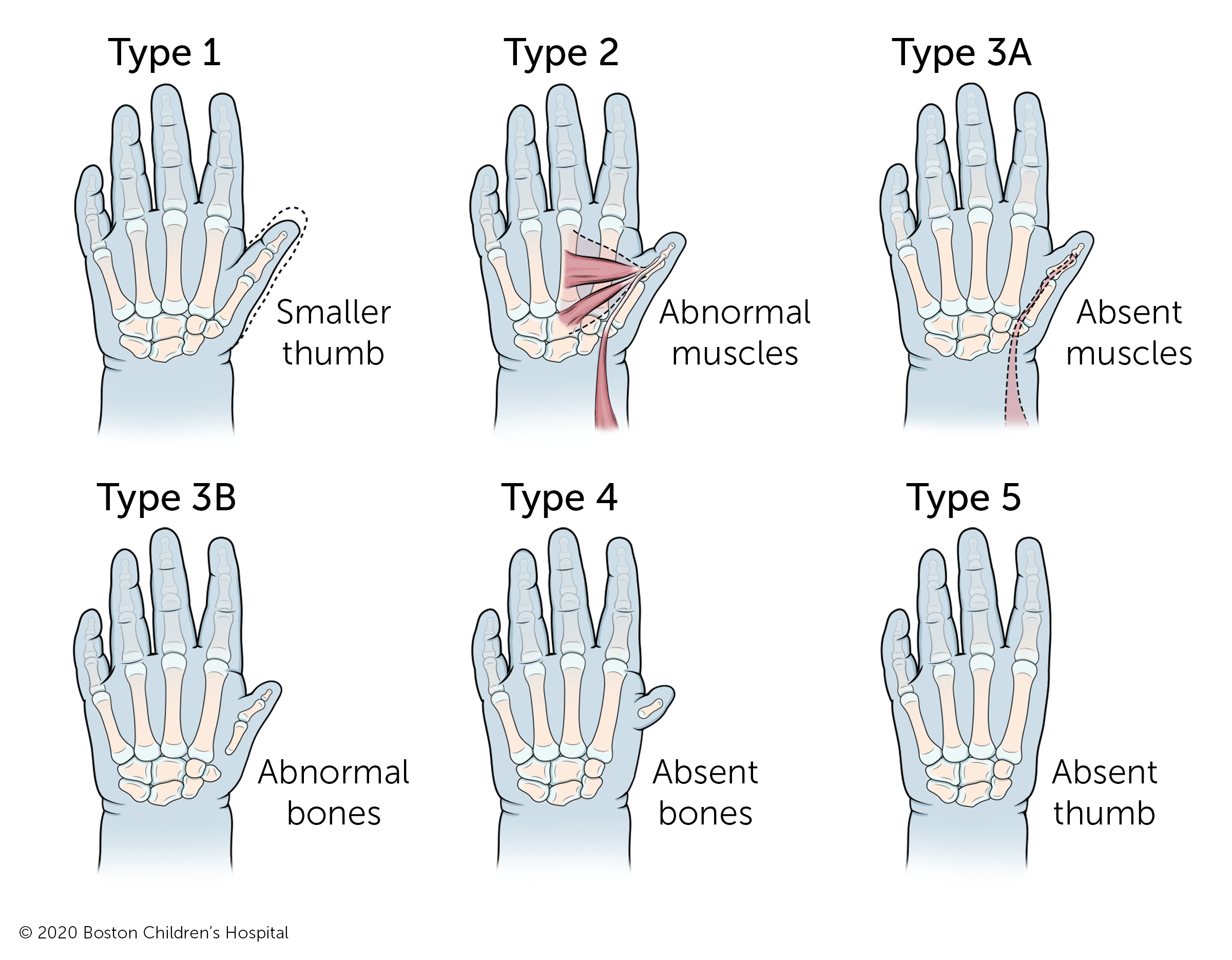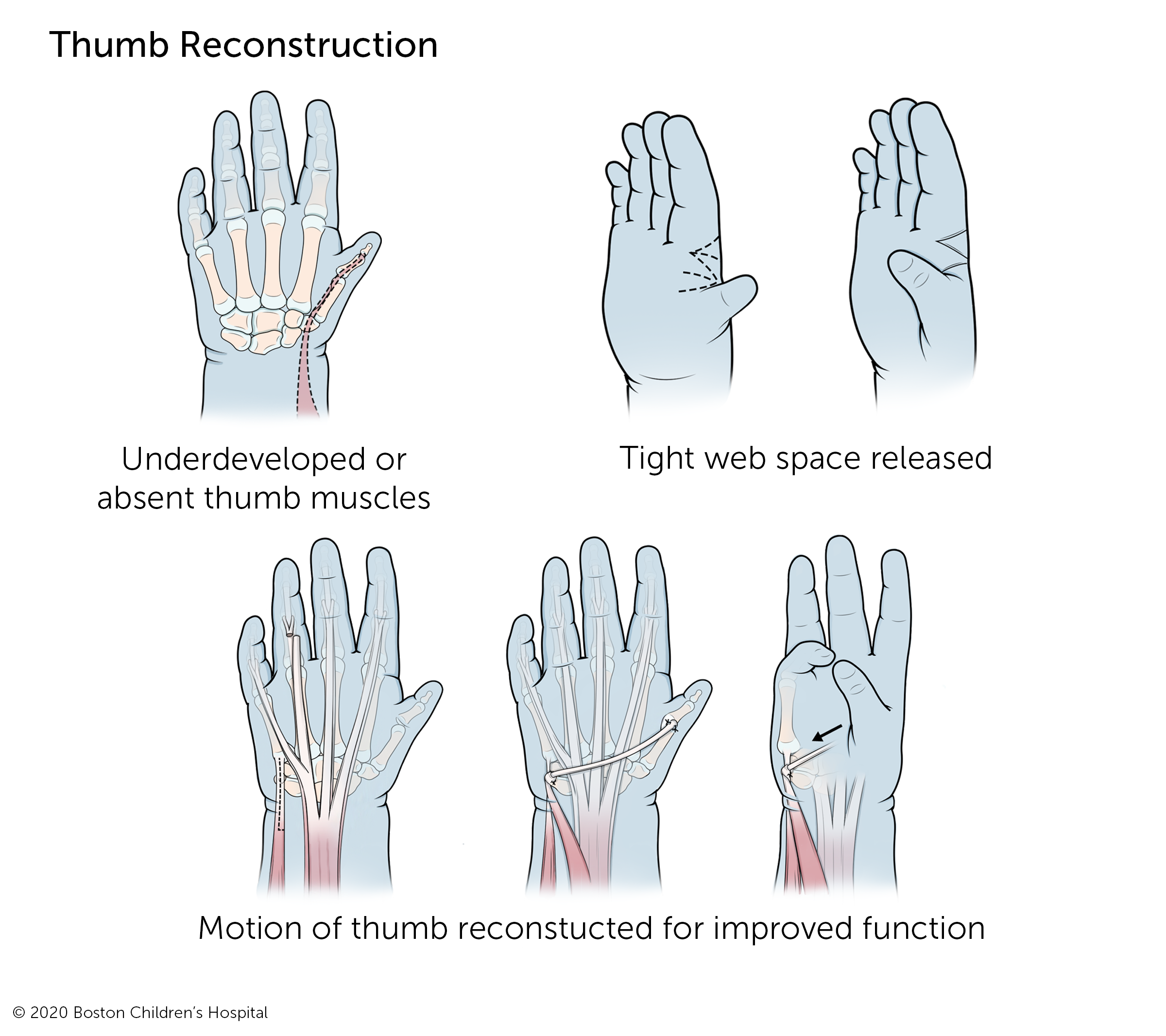Thumb Hypoplasia Aplasia | Symptoms & Causes
What are the symptoms of thumb hypoplasia and aplasia?
There are several types of thumb hypoplasia and aplasia. Your child’s symptoms will depend on what type they have.

Type 1
The thumb is slightly smaller than normal, but all of its structures — the bones, tendons, ligaments, muscles, and joints — are normal. Children with this type of thumb hypoplasia do not typically need surgery.
Type 2
The thumb is small and there are often minor abnormalities in the tendons and muscles within the thumb. The bones of the thumb are small and the middle joint of the thumb is unstable. The thumb may therefore wobble. Because the web space between the thumb and index finger is tight, the thumb has limited movement. Thumb reconstruction surgery may be recommended to improve the strength of the thumb.
Type 3
The bones of the thumb are small, and there are abnormalities in many or all of the muscles of the thumb along with a range of problems in the joints of the thumb. The web space between the thumb and index finger is tight and limits movement. Depending on the stability of the thumb, either a thumb reconstruction or index pollicization is generally recommended.
Type 4
The thumb has no bony support and is attached to the hand by only skin and soft tissue. Index pollicization surgery is generally recommended.
Type 5
The thumb is missing altogether. Index pollicization surgery may be recommended.
What causes a child’s thumb to be underdeveloped or missing?
The cause of this condition is unknown. However, it often happens together with radial longitudinal deficiency (radial club hand). It can also happen in association with Holt-Oram and Fanconi syndromes and VACTERL sequence.
Thumb Hypoplasia Aplasia | Diagnosis & Treatments
How are thumb hypoplasia and aplasia diagnosed?
Thumb hypoplasia and aplasia are usually seen during a baby’s first newborn exam. Your child’s doctor will look for other deformities that are sometimes associated with this condition. Your child’s doctor may order an x-ray so they can look at the structures of your child’s thumb. They may order other tests if they suspect another condition.
How are thumb hypoplasia and aplasia treated?
The decision about whether or not thumb hypoplasia or aplasia should be treated is not always straightforward. Children adapt and can function with a missing finger. If untreated, children who have no use of a thumb can learn to pinch objects using their long and index fingers. But they may have problems with pinch strength as well as activities that require holding larger objects. Surgeries for thumb hypoplasia are designed to help with these issues.
Your child’s treatment may include one or more of the following:
Occupational therapy
If your child has a mild case of thumb hypoplasia and their thumb is slightly short or weak, or if the web space between their thumb and index finger is slightly tight and prevents mobility, occupational therapy will help them adapt. If your child has surgery, occupational therapy will be essential after the surgery to maximize results.
Thumb reconstruction surgery
This surgery reconstructs the ligaments in the thumb to stabilize the middle joint and improve function and stability by transferring a tendon from another part of the hand. It may also involve an operation to release the tight web space between the thumb and index finger using a skin graft.
Thumb reconstruction can be done when your child is 1 year old or up through when they are school-age.

Index pollicization surgery
This surgery may be an option if your child has no thumb or severe hypoplasia. The operation involves creating a functional thumb by transferring another finger (usually the index finger) to the thumb position.
If there are no other pressing medical concerns that need to be addressed, pollicization surgery is generally performed when your child is between 6 to 18 months old.

After surgery or occupational therapy, your child’s thumb should function very well, although some differences in strength and appearance are common.
How we care for thumb hypoplasia and aplasia at Boston Children’s Hospital
The Orthopedic Center’s Hand and Orthopedic Upper Extremity Program and our Department of Plastic and Oral Surgery's Hand and Reconstructive Microsurgery Program have treated thousands of babies and children with thumb hypoplasia and aplasia and other hand problems. We are experienced treating conditions that range from routine to highly complex, and can provide your child with expert diagnosis, treatment, and care. We also offer the benefits of some of the most advanced clinical and scientific research in the world.
Our Orthopedic Center is nationally known as the preeminent center for the care of children and young adults with a wide range of developmental, congenital, neuromuscular, sports-related, traumatic, and post-traumatic problems of the musculoskeletal system.
Our Department of Plastic and Oral Surgery is one of the largest and most experienced pediatric plastic and oral surgery centers anywhere in the world. We provide comprehensive care and treatment for a wide variety of congenital and acquired conditions, including hand deformities.

